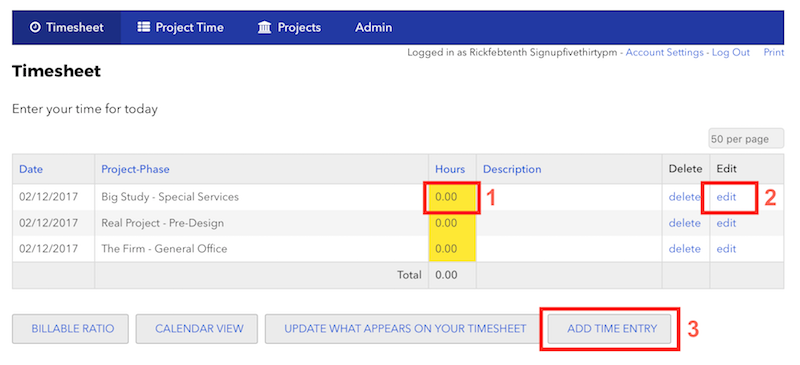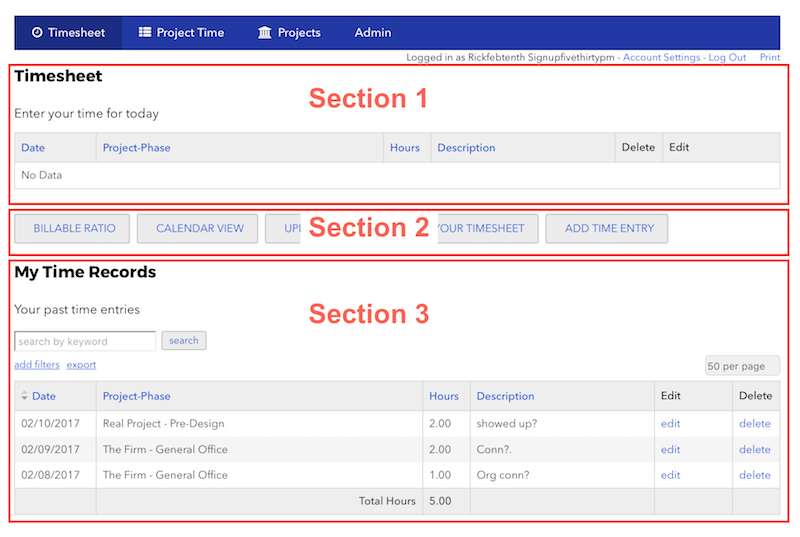|
How often do you complete your timesheet? I personally have used twice-monthly, weekly, and daily timesheets. You are probably different than me; but when I filled out my timesheet it usually went something like this ... Twice Monthly The timesheet had all the firm's projects listed down the left side and all the days of the time period across the top. There were totals for each day and for each project. The format varied over time from paper form, electronic spreadsheet, to software. More about that later.
My accuracy varied by how often I did this during the time period.
Weekly Much the same process and results. Daily Daily - still simpler process. 1) Recollect the days activities. 2) Maybe glance at email to jog my memory. Results - 95%+. 'A', "well done". Twice daily - almost real time logging of results. I'd say 98% accuracy, "just showing off". It seems that accuracy, at least for me, increases with frequency. Amazing! Who Cares Well, the people that benefit from higher accuracy. The boss(es), the client, maybe you. Here are the benefits. More income – virtually nothing falls through the cracks so the firm gets paid for everything it does. More income for the same effort will lead to profit and bonuses. More honesty – we all know that some people ‘game’ the system. When the reporting time frame is a week, two weeks, a month (horrors!), the time sheet exercise becomes more about "what should have happened" or "what you want ‘the boss’ to think happened". It’s a lie that hurts somebody – the client, the firm, co-workers. Trying to operate a firm based on dishonesty is going to undermine the firm's finances eventually. No profit, no bonuses, finally layoffs. More realism – a more realistic view of what is going on is a really good thing for everyone. You can’t fix problems that you don’t know about. Daily timesheets give you information about who’s working on what, and how much time has been spent for the results delivered. Knowing this, you can give kudos, or you can take corrective action. Faster invoicing – when all the data is already in, invoicing can be done in a snap. Invoicing once a month means you have a lot of time that you have already paid out through payroll. Don’t wait another week or more before your client even sees the invoice, which is when the meter starts ticking on getting paid. If getting paid drags out too long, you will start thinking you need a 'working capital' loan to fill the gap between spending and income. Loans are only good for bankers. The How To We were accustomed to twice monthly timesheets due on the 1st and the 16th when we first introduced daily time sheets. The bitching was magnificent! "The problems! The extra time! The disruptions!" In less than one month everyone was on board and the world didn’t end as predicted. Make the new rule clear, set an example, and dun any slackers until they decide compliance is the lesser of two evils. Use embarrassment if needed. Every morning we sent a group email reminder about daily timesheets and listed who was missing timesheets. The Options While technically you can use any method to report your time daily, one method stands out. Cloud-based timekeeping apps. The other options: Network-Based Software Option Those using network-based software usually report that they are using QuickBooks. Two other sizable minorities are Axium by Ajera and Vision by Deltek. ArchiOffice is a distant third minority. A surprising number of QuickBooks users volunteer that they dislike this solution for time sheets, often describing spreadsheet or paper work-arounds. See Spreadsheets and Paper below for how time-consuming those solutions are. Deltek, Ajera and ArchiOffice do have integrated time sheets, although satisfaction with those systems runs low. These are all true accounting systems and they require a lot of maintenance 'overhead' to keep the accounting balanced. My firm used Deltek for over twenty years. You need a part-time person just to nurse the monster. Electronic Spreadsheets Option You can use a homemade spreadsheet for collecting time, but it takes a lot of management. The best method we found with this system is for one person to manage a time sheet folder containing each person’s time sheet, which is a separate XLS workbook. By having each XLS workbook reference a ‘summary’ workbook you can add projects just once and get all the totals added up automatically. Using one shared workbook is a mess because no one remembers to close it when they are finished updating. As projects come and go, the maintenance is lots heavier. Spreadsheets require lots of management by someone to keep the projects/phases/tasks up to date – and to publish a new spreadsheet workbook each pay period. I think spreadsheet-based timesheet management can take at least an hour per month per staff member. This has a cost that is often ignored. We had an architect doing this and, therefore, not doing billable work. You might be paying a bookkeeper for those hours. Or perhaps you are using a clerical staff member who could be using those hours to improve your marketing. However you keep the spreadsheets up to date, it is not a free process. Paper Forms Option Paper time sheets have the warmth of tradition to recommend them, but they lead to two problems – inefficient time use and inaccuracy. First, although filling out the form itself is efficient, you must transcribe it in order to use the data. Once you 'interpret' the add-on projects, you compile the results. Then you embark on the time-wasting chores described above for spreadsheets to create the next form. The second problem is that you don’t want to face this chore very often, so bi-monthly time sheets are the norm. My guess is that some of these time sheets dip into 'D' territory, grade-wise. The Ideal Option
Here is the ideal - a cloud-based app. This means the software is accessed through your browser or a mobile app that runs on your phone or tablet. There is no software to maintain, no servers to own and your data is backed-up for you better than you would do it on your own; but you can still save your data by exporting it for extra security. Once or more a day, you open the app in the browser you already use. This means you can be anywhere there is internet, or, if using your phone or tablet, you can be anywhere with a cellular signal. With a few clicks and key strokes you enter the projects/phases/tasks/hours and maybe a description of what you worked on. DONE. A few times a month you open a new project or phase. Until your G-glasses can record all this for you as you work, this is as simple as time sheets get. Admittedly the time entry isn't much different than the other options, but the simplicity comes from avoiding all the other hassles that you get from other options - interpreting new entries, compiling the time by project, updating the form or spreadsheet, software and server 'overhead'. Above is the Timesheet page of the MyCorbu app that I have developed. You can 'test drive' MyCorbu to see what I am talking about. Of course, the fact that your time is stored and compiled every day is an enormous advantage. Not even the networked systems that I am familiar with let you see your month to date results any time that you like. (Accounting requires 'posting'.) It is really nice to know how the month, and each project, is going without waiting for the invoicing process to finally show you the historical data. Comments are closed.
|
x
Archives
February 2024
Categories
All
|
Architekwiki | Architect's Resource | Greater Cincinnati
© 2012-2022 Architekwiki
© 2012-2022 Architekwiki









